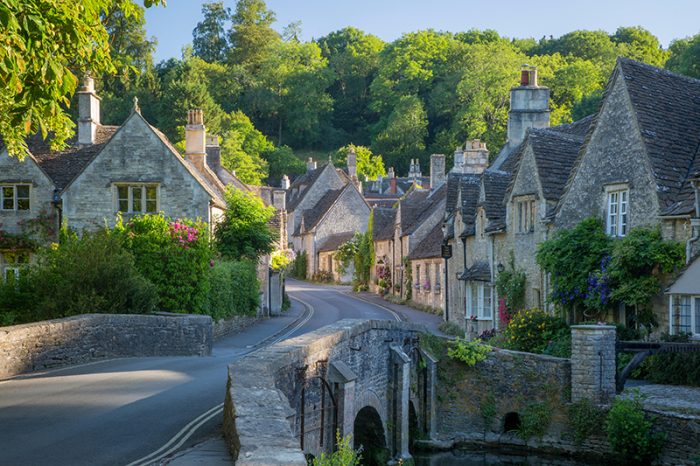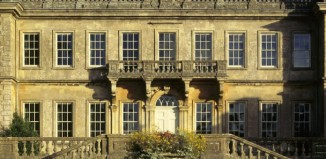Britain’s prettiest streets
We take a stroll along Britain’s prettiest streets to uncover charming architecture, chequered histories and cinematic vistas
The Street
Castle Combe, Wiltshire
Regularly voted the prettiest village in England, the cute Cotswolds community of Castle Combe is so small that most of its appeal rests on a single thoroughfare, known rather definitively as The Street. Snaking down the hill from Upper Castle Combe to the babbling By Brook, it is something of a two-colour street, as the green tree arches that encase the top of the hill make way for the honey-gold of the Cotswold-stone cottages.
The Street opens out at the junction with West Street with the 14th-century market cross, a lasting reminder of the parish’s once-popular clothing market that was supplied by Wiltshire’s various mills and dye houses, the last of which died out in the early 1800s. With hanging baskets brightening every doorway and an adjacent Grade I-listed church, the marketplace paints a vivid picture of English village life, so much so that keen-eyed viewers of Downton Abbey and Steven Spielberg’s War Horse may realise they have seen this all-too-familiar scene before.
If you’re keen to spend some time here, Castle Combe is blessed with plenty of historic accommodation despite its size. The five-star Manor House backs onto its own 18-hole championship golf course, while its sister property, the medieval Castle Inn, looks out onto the market cross. Refreshments are also available on The Street courtesy of The White Hart pub and the 15th-century Old Rectory Tea Room, complete with secret garden, while the cities of Bath and Bristol are also just a 20-minute drive away.
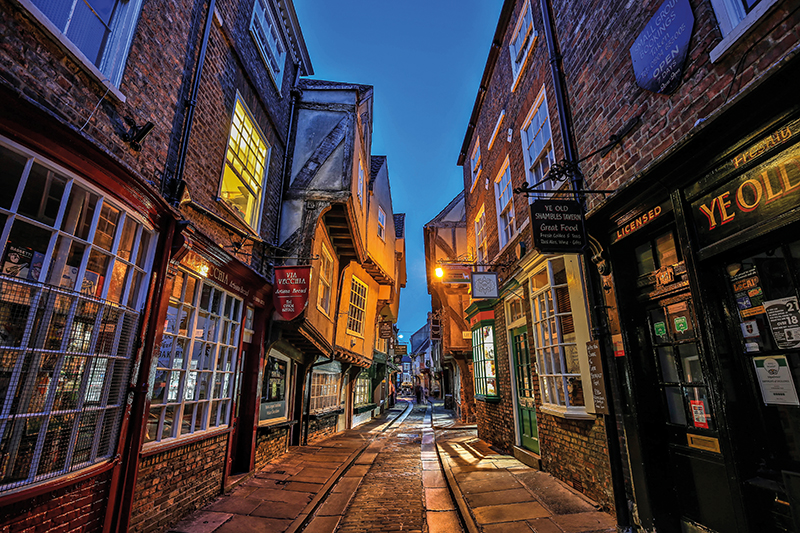
Shambles
York, Yorkshire
Few streets conjure up such vivid images of medieval Britain as York’s Shambles, or The Shambles as the maze of surrounding lanes is collectively known. Wander along the main street where timber-framed buildings peer down over passersby, the overhanging façades leaving just a narrow slip of blue sky in between.
Indeed, in some sections, the gap at street level is so narrow that one can touch the buildings on both sides with outstretched arms. Yet their proximity is far from accidental. In fact, this medieval street, which served as a string of butchers’ shops and slaughterhouses, was carefully designed this way. By closing the gap between opposite sides, the tall buildings provided shelter for the rows of meat strung up on shelves beneath, keeping the goods out of direct sunlight. Raised pavements on either side provided another practical solution, allowing the butchers to wash away all the gory leftovers.
Today, visitors to the city will be pleased to learn that conditions are far more sanitary. The pretty Shambles shop fronts have been restored and now house a variety of quaint cafés, antique shops and independent boutiques, with highlights including award-winning local produce at Ye Olde Pie and Sausage Shoppe, and guided tours at York’s Chocolate Story, which celebrates the home of confectionery giants Rowntree’s and Terry’s.
Despite the restorations, eagle-eyed visitors might spot some of the original shop-front shelves. A key element of this iconic street’s history (the very name Shambles is thought to have derived from ‘shammel’, an Anglo-Saxon word for shelves), they’re well worth seeking out.
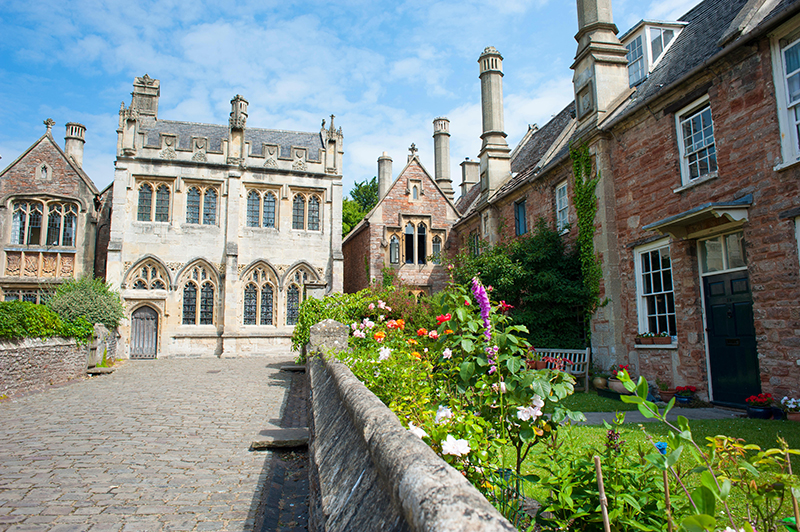
Vicars’ Close
Wells, Somerset
In the shadow of Wells Cathedral lies Vicars’ Close, believed to be the oldest surviving example of a complete residential street in Europe. Under the guidance of Ralph of Shrewsbury, Bishop of Bath and Wells, work began on the 42 original houses in 1348. To put that into context, this was more than 350 years before the founding of the oldest residential street in the US (Elfreth’s Alley in Philadelphia), and the year the Black Death was sweeping across Europe claiming tens of millions of lives.
The first houses were built, as the street name suggests, for chantry priests on land granted by the Archdeacon of Bath, Walter de Hull. By the mid-15th century, the distinctive chimney shafts were added and the vicars requested gardens, which changed the look of the place from a wider, university-style quadrangle to the more direct street as it appears today. Many of the modestly apportioned houses have since been renovated or two adjacent properties have been knocked through to create one larger residence (there are now 27 in total).
In fact, while this picturesque close remains almost entirely residential, there are plenty of nearby attractions in England’s smallest city. The cathedral’s interior is a must-see, a symphony of colour and curves with the ornate stained glass of the Jesse Window and the dazzling Scissor Arches, a ‘modern addition’ to the 12th-century building in the mid-1300s. Several of the replaced cathedral statues can be seen in the adjacent Wells and Mendip Museum (alongside a fantastical Jurassic-era sea dragon fossil), while to the south lies the Bishop’s Palace with its moat – popular with swans – and 14 acres of diverse gardens.
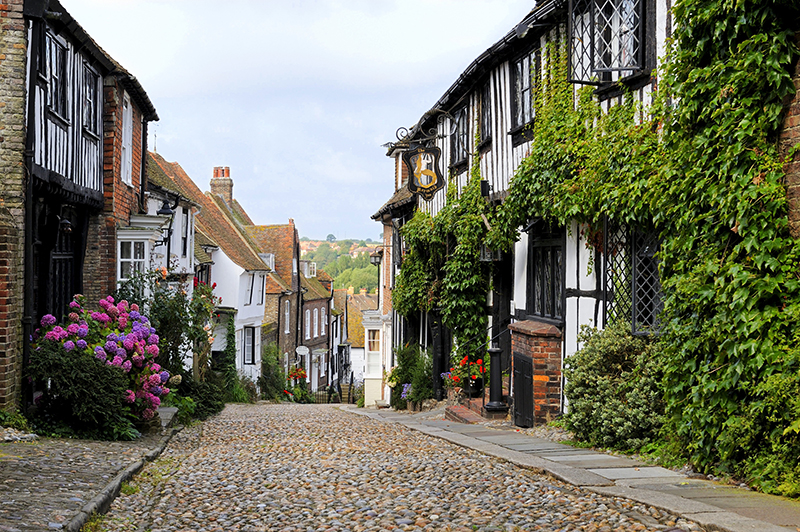
Mermaid Street
Rye, East Sussex
Visit Mermaid Street today and one can glean little inkling of its former appearance. A chocolate-box combination of half-timbered and Georgian houses, trailing greenery and neat cobbles, this quaint street in the medieval town of Rye really is as pretty as a picture. Yet, according to data from the 1891 census, it hasn’t always been quite so photogenic.
In fact, the street was rather more unkempt well into the 20th century, in part due to its location leading off from the main port area at the Strand. Today, this is a distant memory – not least because the sea has long since retreated from the town. The Strand is now a picturesque hub of rustic antiques shops, seafood restaurants and traditional pubs. And it’s a mere stone’s throw from more of the same on Mermaid Street and its surrounding lanes and alleys, which makes exploring the area on foot particularly pleasant.
In terms of essential stop-offs, a visit to The Mermaid Inn is a rite of passage for any visitor, and it’s hardly an inconvenience. Rebuilt in 1420, with cellars that date back to 1156, its rooms are an exquisite mix of rich wood-panelled walls, vast brick fireplaces and creaking floorboards. A tour of the upstairs bed chambers is highly recommended. From one, a secret passage leads to a hidden priest hole, which once provided a safe haven when Catholics were persecuted by English law. It’s tucked into the chimneybreast of the Giant’s Fireplace Bar, which was a favourite haunt of the Hawkhurst Gang of smugglers.
Infamous smugglers and fleeing priests aside, Mermaid Street has a far more recent association in the form of author EF Benson’s Mapp and Lucia. The two female characters of Benson’s tongue-in-cheek novels were established in the 1920s and 30s and garnered quite a following at the time.
Their fictional location – Tilling – is very closely based on Rye, the author’s home for many years. Porpoise Street is Mermaid Street’s fictional counterpart, for example, and one can visit many more of the streets and locations parodied in the books, as well as Benson’s gravestone in the churchyard and his former home of Lamb House. The latter, which is on West Street, around the corner from the Mermaid Inn, is today run by the National Trust and celebrates its association with Benson and the esteemed American novelist Henry James, who lived there for 19 years before his death in 1916.
Elsewhere, Mermaid Street holds many more surprises. Ancient buildings are plentiful along this stretch of cobbles, complete with whimsical names like The House Opposite and The House with the Seat. Courtyards, arches and alleys hide tucked-away tearooms and independent shops, and the place has an unhurried, leisurely feel. It’s all complemented by a soundtrack provided by the Quarter Boys on the clock of St Mary’s. As the name suggests, they strike not on the hour, but at 15-minute intervals. Eccentric perhaps, but one would expect nothing less from this one-of-a-kind town.
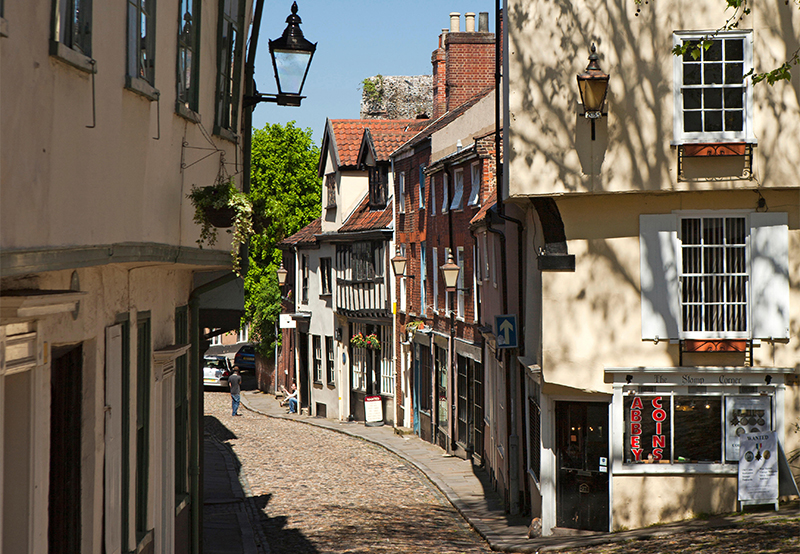
Elm Hill
Norwich, Norfolk
Elm Hill is no stranger to the limelight. This iconic Norwich lane, which stretches from Princes Street to Wensum Street, has graced countless postcards, guidebooks and chocolate boxes, and even featured in the 2007 fantasy adventure film, Stardust, adapted from Neil Gaiman’s novel of the same name.
One look at this picturesque scene quickly reveals its camera-worthy credentials. Pastel-painted houses and timber-framed buildings line the gently winding cobbled street, and the line-up of shops lacks big-name brands. Instead, antiques dealers and secondhand bookstores jostle for attention, bolstered by tearooms and coffee shops. Local contemporary art is celebrated at Mandell’s Gallery, while The Bear Shop is a must for stuffed toy collectors. The street takes its name from the elm trees planted here in the early 16th century. Alas, after a bout of Dutch elm disease in the 1970s, those trees are gone – the only surviving tree in the square is a different species.
Overlooking that square is The Britons Arms, a former Tudor inn and Elm Hill’s only building to have survived a fire in 1507, when the town was almost entirely destroyed. Thankfully, the area was rebuilt and restored, and is now considered one of Britain’s undisputed treasures. Late on a summer’s evening, when the crowds thin and the street takes on a hazy, golden glow, it’s easy to see why.
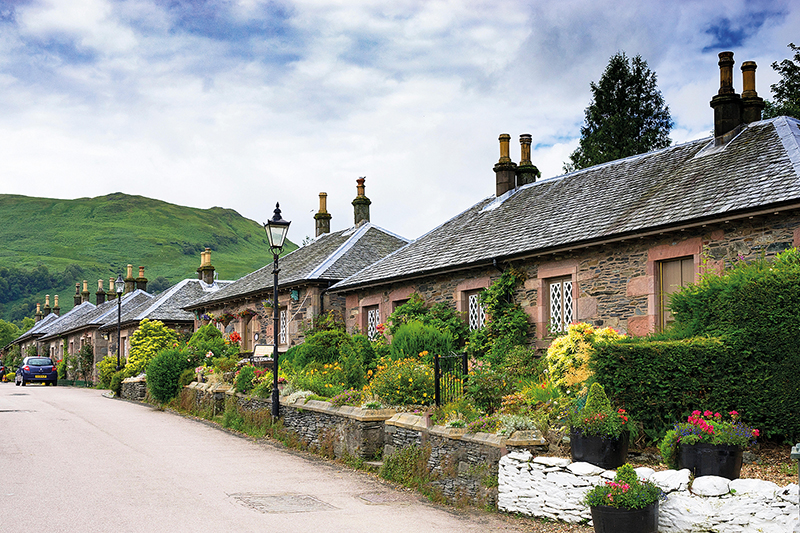
Pier Road
Luss, Argyll & Bute
In the picturesque Scottish village of Luss, during the late 18th and 19th centuries, the hills were alive not with the sound of music, but rather the din of slate mining. Demand was high for these lightweight, blue-purple slates, which still grace many of Glasgow’s tenement roofs today.
Perched on the west bank of Loch Lomond, Luss has been a settlement since medieval times, yet the booming industry in the Victorian era led to many gorgeous, low-rise workers’ cottages springing up in the shadows of Glen Luss, which in turn saw the place become a designated conservation village. Pier Road is a picture-perfect thoroughfare, dotted with almost-identical sandstone-and-slate bungalows. With the cottages’ rose-laden gardens, the road became a regular feature in the TV soap opera Take the High Road, in which Luss doubled as the fictional village of Glendarroch.
Though largely residential, there are several B&Bs along Pier Road, as well as the McVey family’s bistro-style café, The Village Rest, and the Luss General Store, which is filled with gift cards and local handicrafts. From here, it is a gentle stroll down to Luss Pier, a rickety and atmospheric structure reaching out into the depths of Loch Lomond beyond. In the summer, Sweeney’s Cruise Company runs a one-hour cruise from Luss Pier to Balloch on the loch’s southern shore, complete with a pre-recorded onboard commentary from BBC TV presenter Neil Oliver.
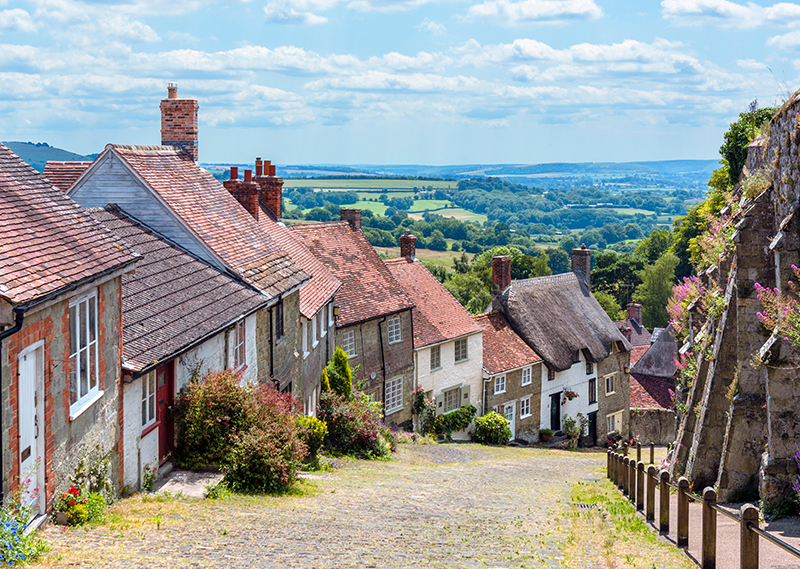
Gold Hill
Shaftesbury, Dorset
It’s been more than 40 years since television viewers first watched a young bread delivery boy push his bike up Gold Hill in an advert for Hovis bread. And yet, the image of this classic cobblestone street – captured by a young Ridley Scott, director of Blade Runner and Alien, in 1973 – endures to such an extent that many know it simply as Hovis Hill. Indeed, an extra-large Hovis loaf greets visitors on the approach to the street, in a nod to the original advert. But what else do we know about the once unfamiliar Dorset street that has become a true slice of British TV history? First, Gold Hill is one of the country’s steepest – the street’s stone cottages scale an incline in excess of 16 degrees, so the view from the summit is not the only thing to take one’s breath away.
Also, at the top of the hill stands the 14th-century St Peter’s Church, the oldest in Shaftesbury. There is a charming local history museum next door. The Gold Hill Museum is housed in the former priest’s house, with a hagioscope – or ‘squint’, a small, splayed opening – through to the neighbouring church still in place.
Museum admission is free, and one of the jewels in the collection’s crown is the Byzant, once carried in the town’s annual procession. Each year, residents of the hilltop town honoured the Lord of the Manor of Motcombe for allowing them to use water from the village below. It’s a resource that cannot be underestimated, considering the town’s lofty location.
A fascinating collection of historical artefacts aside, the museum also boasts a charming cottage garden with cinematic views of Blackmore Vale, once home
to Tess of the D’Urbervilles author Thomas Hardy. Likewise, the vista from Park Lane, to the right of Gold Hill, is a verdant patchwork of lush green fields that stretches off into the distance.
Alternatively, if you visit in mid-winter, when the landscape is cloaked in snow, the scene takes on a monochromatic appearance worthy of any Christmas card. In either case, few can deny that the view from the top of Gold Hill deserves so much attention. The most-photographed angle is undoubtedly looking over the row of thatched roofs that meander downwards into the surrounding English countryside like a lazy river. From here, it’s easy to see why the scene has also been captured in numerous films, including the 1967 adaptation of Hardy’s Far from the Madding Crowd.
Viewing the hill from its base has a certain charm that is all too often overlooked. From here, the moss-covered cobbles and jaunty roofs become a kind of rickety staircase that leads up, seemingly, into the clouds.
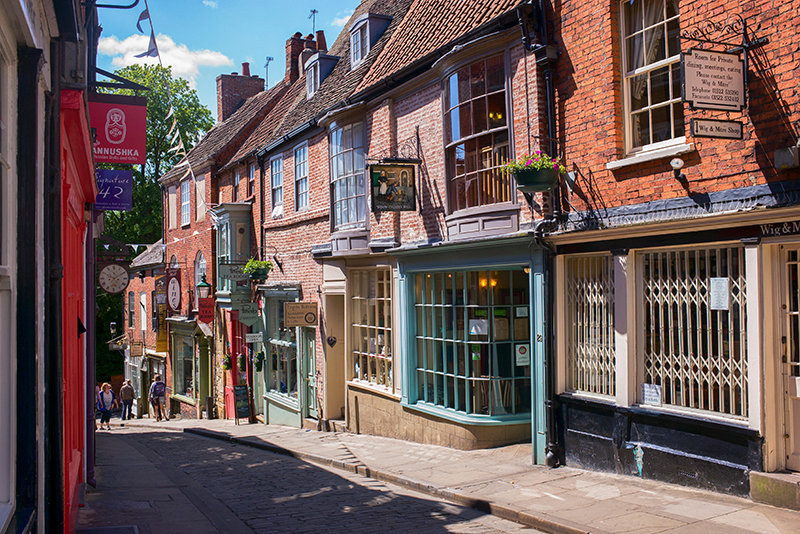
Steep Hill
Lincoln, Lincolnshire
While many of the streets selected here are prized for their ramshackle charm, Lincoln’s Steep Hill has been held up as an admirable example to generations
of architecture and town-planning students. In 2012, it received the Great Street Award from the Academy of Urbanism, which praised its ability to “adapt while respecting and enhancing its heritage”.
The award was fully deserved. Steep Hill remains an active and integral part of the city, connecting the High Street to the recently renovated Lincoln Cathedral, which was the world’s tallest building for 238 years after the central tower was rebuilt in 1311. And despite the sharp incline (at a gradient of about eight degrees that handrail isn’t just for decoration) and the transitory nature of the street, it has retained a proud, community feel with private homes above the pastel-coloured boutiques. (There is a shuttle bus for those less able or willing to trudge up such steep angles.)
Shopping highlights include secondhand bookshops, antiques dealers, and the sweets-in-jars of vintage confectioners Goodies of Lincoln.
Historical curios line the hill too, particularly connected to the city’s 12th-century status as a thriving Jewish community, before the Jews were expelled from England in 1290. The Jews House Restaurant is housed in one of the oldest continuously occupied dwellings in England, while Norman House, now home to Imperial Teas shop and café, was built in 1170 for a Jewish moneylender whose clients included King Henry II.

